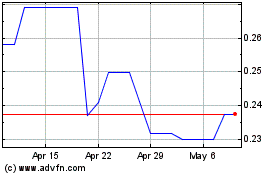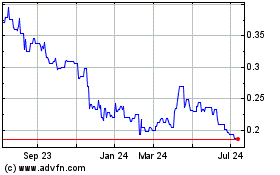By Rhiannon Hoyle
SYDNEY-- BHP Billiton Ltd. announced its largest-ever write-down
Friday, a roughly US$7.2 billion pretax charge against its U.S.
onshore energy assets as the downturn in global commodity prices
bites deeper into industry profits.
Free-falling oil prices are the latest headache for the global
mining giant, which is already grappling with a dam burst at a
Brazilian mining venture and a collapse in prices for iron ore, the
focus of its biggest division. The company's shares have plunged
16% in the early days of 2016.
The write-down against the energy unit surpasses US$5.5 billion
of charges reported in 2013 across several assets, previously its
biggest impairment on record. It also adds to a series of
write-downs against that business, including a pretax charge of
US$2.8 billion last year, and another of similar size in 2012.
BHP isn't alone. Resources giants around the world have written
down the value of assets amid the sharp downturn in markets.
This week, Sherritt International Corp. of Canada said it
expects a write down of US$2.4 billion against a nickel project in
Madagascar it owns with Japanese trading company Sumitomo Corp. and
state-run Korea Resources Corp.
Some of the world's biggest oil companies, including Royal Dutch
Shell PLC, have also been writing down the value of assets as
prices slump.
BHP plowed about $20 billion into U.S. shale-gas businesses in
2011, and has since spent billions a year exploring and developing
assets to become one of the biggest petroleum producers outside of
the large integrated oil companies such as Shell and Exxon Mobil
Corp. Chief Executive Andrew Mackenzie designated oil and gas as
one of "four pillars" of BHP's business, alongside iron ore, copper
and coal.
Investors previously rewarded BHP for having big operations in a
range of commodities including energy -- a strategy designed to
insulate the company from different price cycles. But it has now
come under pressure as prices have tumbled across the board.
For investors, the latest write-down wasn't unexpected, although
its scale caught some off guard.
"A US$7.2-billion write-down is huge in anyone's book, even a
company the size of BHP," said Angus Nicholson, a Melbourne-based
analyst at broker IG.
Still, many fund managers argue the charge, described as
disappointing by Mr. Mackenzie, takes second billing to something
much more important to investors: the dividend outlook.
In August BHP recorded its worst annual profit result since
2003. It has since been beset with problems following a major dam
burst in November at a mine operated by Samarco Mineracao SA, a
50-50 joint venture with Brazil's Vale SA.
Prices of key commodities such as iron ore and copper have
fallen to their lowest in as much as a decade amid a global
oversupply as concerns about China's economy have increased.
BHP's share price has plunged by 40% over the past three months,
and it is now under pressure to cut its dividend to shore up its
balance sheet.
"BHP is being penalized by investors for the uncertainty over
its dividend policy," said Pengana Capital fund manager Ric Ronge,
calling it a "more pressing issue that management has to
address."
"Its dividend payout isn't really reflecting its earning
ability," he said.
Barclays forecasts the miner will be forced to cut investor
payouts by half.
BHP said Friday's write-down, which would total about $4.9
billion after taxes, reflects downgraded projections for energy
prices and revisions to its development plans, "which have more
than offset substantial productivity improvements."
It said its investment plans for the U.S. onshore business for
the rest of the fiscal year through June are under review, with the
focus is on preserving cash flow.
Meanwhile, the company will this quarter cut the number of rigs
it operates in the business to five from seven, retaining three in
the Black Hawk field in the southern Texas Eagle Ford region, and
two in the nearby Permian Basin.
Oil prices this week slipped below $30 a barrel for the first
time in more than 10 years. The sharp downturn from above US$100 as
recently as 2014 has been greased by a global glut of crude. U.S.
inventories of crude and refined products rose modestly to stay
near highs not seen this time of year in at least eight decades,
the U.S. Energy Information Administration said.
The market also anticipates an increase of Iranian oil exports
as international sanctions against Tehran's nuclear program are
lifted. This would add to the persistent oversupply of crude around
the globe, analysts say.
Morgan Stanley recently called the energy-pricing environment
"worse than 1986," the last big oil bust that lasted for years.
American oil-and-gas producers are projected to slash their budgets
by 51% to US$89.6 billion from 2014, a cut that exceeds the worst
years of the 1980s, according to Cowen Co.
"Oil and gas markets have been significantly weaker than the
industry expected," Mr. Mackenzie said.
BHP said the write-down would reduce the net value of its
onshore U.S. operating assets to about $16 billion.
Write to Rhiannon Hoyle at rhiannon.hoyle@wsj.com
(END) Dow Jones Newswires
January 15, 2016 02:33 ET (07:33 GMT)
Copyright (c) 2016 Dow Jones & Company, Inc.
Sherritt (PK) (USOTC:SHERF)
Historical Stock Chart
From Mar 2024 to Apr 2024

Sherritt (PK) (USOTC:SHERF)
Historical Stock Chart
From Apr 2023 to Apr 2024
